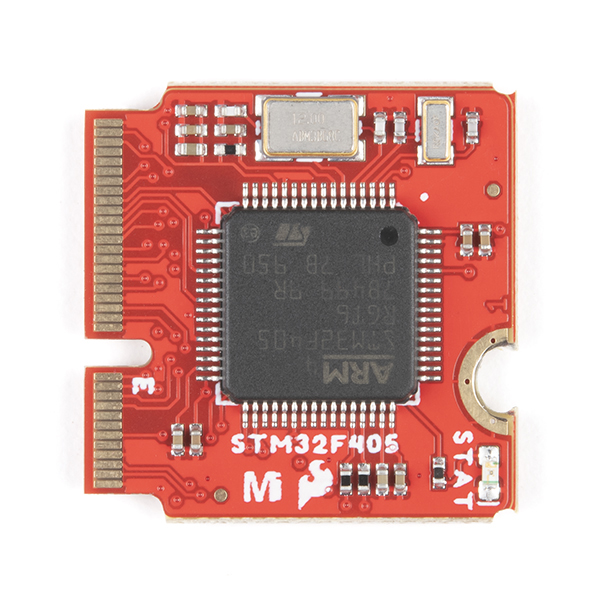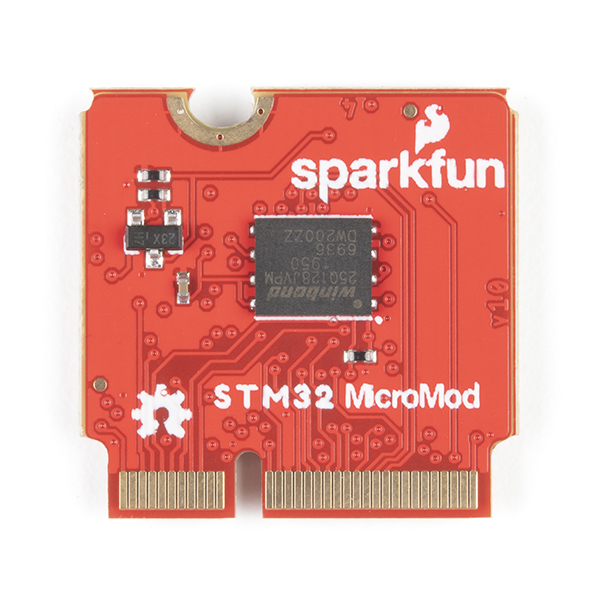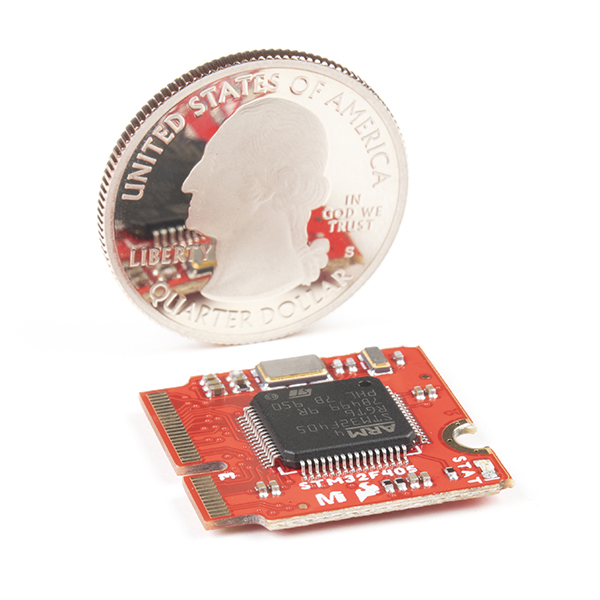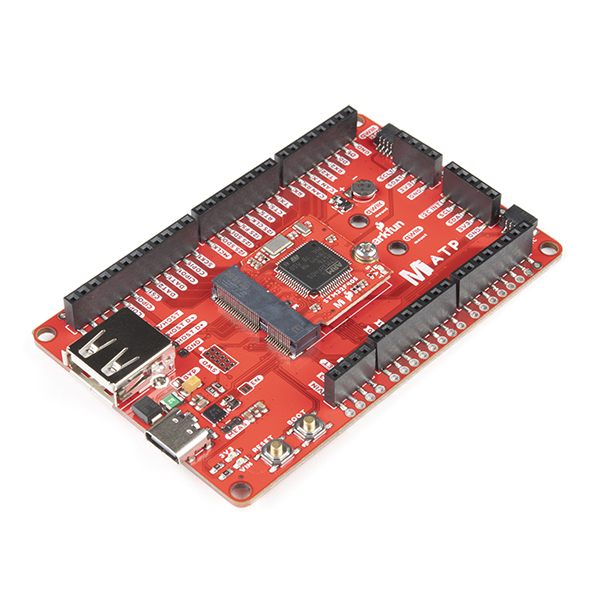SparkFun MicroMod STM32 Processor
The SparkFun MicroMod STM32 Processor Board is ready to rock your MicroMod world with its ARM® Cortex®-M4 32-bit RISC core! This little Processor Board provides you with an economical and easy to use development platform if you're needing more power with minimal working space. With the M.2 MicroMod connector, connecting your STM32 Processor is a breeze. Simply match up the key on your processor's beveled edge connector to the key on the M.2 connector and secure it with a screw (included with all Carrier Boards). The STM32 is one of the most powerful and economical microcontrollers available so to be able to add it to your MicroMod Carrier Board is a huge advantage for your project!
As we previously stated; the STM32F405 Processor is based on the high-performance ARM® Cortex®-M4 32-bit RISC core and can operate at a frequency of up to 168 MHz. This core features a floating point unit (FPU) single precision which supports all ARM single precision data-processing instructions and data types. It also implements a full set of DSP instructions and a memory protection unit (MPU) which enhances application security. This Processor Board utilizes the DFU bootloader for uploading code, and incorporates an extensive range of enhanced I/Os and peripherals. To complement the STM32F405 processor, we've also added an additional 128Mb (16MB) serial flash memory chip to the underside of the board.
MicroMod is a modular interface ecosystem that connects a microcontroller “processor board” to various “carrier board” peripherals. Utilizing the M.2 standard, the MicroMod standard is designed to easily swap out processors on the fly. Pair a specialized carrier board for the project you need with your choice of compatible processor!
STM32 General Features:
- ARM® 32-bit Cortex®-M4 CPU with FPU
- Adaptive real-time accelerator (ART Accelerator™) allowing 0-wait state execution from Flash memory
- Frequency up to 168 MHz
- Memory protection unit
- 210 DMIPS/ 1.25 DMIPS/MHz (Dhrystone 2.1)
- DSP instructions
- 1 MB of Flash memory
- 192 Kbytes of SRAM including 64 Kbytes of CCM (core coupled memory) data RAM
- Flexible static memory controller supporting Compact Flash, SRAM, PSRAM, NOR and NAND memories
- Clock, reset and supply management
- 1.8 V to 3.6 V application supply and I/Os
- 32 kHz oscillator for RTC with calibration
- Internal 32 kHz RC with calibration
- Low-power operation
- Sleep, Stop and Standby modes
- Debug mode
- Serial wire debug (SWD) & JTAG interfaces
- Cortex-M4 Embedded Trace Macrocell™
- Advanced connectivity
- USB 2.0 full-speed device/host/OTG controller with on-chip PHY
- USB 2.0 high-speed/full-speed device/host/OTG controller with dedicated DMA, on-chip full-speed PHY and ULPI
- 10/100 Ethernet MAC with dedicated DMA: supports IEEE 1588v2 hardware, MII/RMII
Specific Peripherals available on MicroMod STM32:
- UART
- Two I2C Buses
- SPI Bus
- PDM Audio Processing
- Two Dedicated Analog Inputs, 15 total analog input capable inputs
- Two Dedicated Digital I/O Pins
- Two Dedicated PWM Pins, 24 total PWM capable
- Nine General Purpose I/O Pins
MicroMod STM32 Processor Documentation:
- Schematic
- Eagle Files
- Hookup Guide
- Board Dimensions
- Datasheet (STM32F405xx)
- Graphical Datasheet
- GitHub Hardware Repo
MicroMod Documentation:
- SparkFun MicroMod Interface v1.0 - Pinout
- SparkFun MicroMod Interface v1.0 - Pin Descriptions
- Getting Started with MicroMod
- Designing with MicroMod
- MicroMod Info Page
- MicroMod Forums
- SparkFun Eagle Libraries contains example footprints for the M.2 connector and SMD standoff
- M.2 MicroMod Connector Datasheet
- MicroMod Reflowable Standoff Datasheet
STM32 Documentation:
SparkFun MicroMod STM32 Processor Product Help and Resources
MicroMod WiFi Function Board - DA16200 Hookup Guide
November 11, 2021
Add IoT functionality to any MicroMod project with the MicroMod WiFi function Board - DA16200!
MicroMod Data Logging Carrier Board Hookup Guide
October 21, 2020
Get started with some customizable MicroMod data logging with the Data Logging Carrier Board.
MicroMod All The Pins (ATP) Carrier Board
October 21, 2020
Access All The Pins (ATP) of the MicroMod Processor Board with the Carrier Board!
MicroMod STM32 Processor Hookup Guide
May 13, 2021
Get started with the MicroMod Ecosystem and the STM32 Processor Board!
SparkFun MicroMod Input and Display Carrier Board Hookup Guide
October 21, 2020
A short Hookup Guide to get started with the SparkFun MicroMod Input and Display Carrier Board
Getting Started with MicroMod
October 21, 2020
Dive into the world of MicroMod - a compact interface to connect a microcontroller to various peripherals via the M.2 Connector!
MicroMod Asset Tracker Carrier Board Hookup Guide
February 25, 2021
Get started with the SparkFun MicroMod Asset Tracker Carrier Board following this Hookup Guide. The Asset Tracker uses the u-blox SARA-R510M8S LTE-M / NB-IoT module to provide a host of data communication options.
MicroMod Machine Learning Carrier Board Hookup Guide
October 21, 2020
Get hacking with this tutorial on our Machine Learning Carrier Board!
Designing with MicroMod
October 21, 2020
This tutorial will walk you through the specs of the MicroMod processor and carrier board as well as the basics of incorporating the MicroMod form factor into your own PCB designs!
Qwiic Digital Desk Sign with MicroMod
June 30, 2022
Make a Qwiic-enabled digital desk sign with a MicroMod SAMD51 Processor Board's USB Host and a USB keyboard!
MicroMod Weather Carrier Board Hookup Guide
January 14, 2021
A quick guide to help to create your own MicroMod weather station using the MicroMod Weather Carrier Board and Processor of your choice.
Core Skill: DIY
Whether it's for assembling a kit, hacking an enclosure, or creating your own parts; the DIY skill is all about knowing how to use tools and the techniques associated with them.
Skill Level: Noob - Basic assembly is required. You may need to provide your own basic tools like a screwdriver, hammer or scissors. Power tools or custom parts are not required. Instructions will be included and easy to follow. Sewing may be required, but only with included patterns.
See all skill levels
Core Skill: Programming
If a board needs code or communicates somehow, you're going to need to know how to program or interface with it. The programming skill is all about communication and code.
Skill Level: Rookie - You will need a better fundamental understand of what code is, and how it works. You will be using beginner-level software and development tools like Arduino. You will be dealing directly with code, but numerous examples and libraries are available. Sensors or shields will communicate with serial or TTL.
See all skill levels
Core Skill: Electrical Prototyping
If it requires power, you need to know how much, what all the pins do, and how to hook it up. You may need to reference datasheets, schematics, and know the ins and outs of electronics.
Skill Level: Rookie - You may be required to know a bit more about the component, such as orientation, or how to hook it up, in addition to power requirements. You will need to understand polarized components.
See all skill levels
Comments
Looking for answers to technical questions?
We welcome your comments and suggestions below. However, if you are looking for solutions to technical questions please see our Technical Assistance page.
Customer Reviews
No reviews yet.






When clicking on the "GET STARTED WITH THE MICROMOD STM32 PROCESSOR GUIDE" link on this page, I am getting the following error:
" Home/ KHAAAAAANNNNN!!!
404 Woah there, Turbo! Our server gnomes couldn't find the page you are looking for.
Seriously, where are you trying to go? "
Did the page move?
Does the MicroMod breakout expose the external memory controller interface?
Nevermind. Looking at the datasheet, there's only the pins to do so on the 100 pin and higher chips. It is simply not possible to expose pins that don't exist.